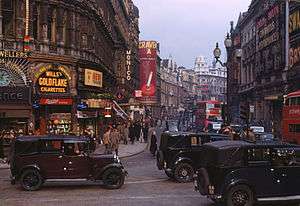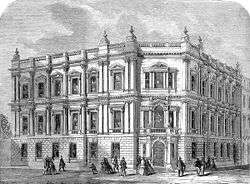Shaftesbury Avenue
Shaftesbury Avenue is a major street in the West End of London, named after Anthony Ashley Cooper, 7th Earl of Shaftesbury. It runs north-easterly from Piccadilly Circus to New Oxford Street, crossing Charing Cross Road at Cambridge Circus. From Piccadilly Circus to Cambridge Circus, it is in the City of Westminster, and from Cambridge Circus to New Oxford Street, it is in the London Borough of Camden.


Shaftesbury Avenue was built between 1877 and 1886 by the architect George Vulliamy and the engineer Sir Joseph Bazalgette,[1][2] to provide a north-south traffic artery through the crowded districts of St. Giles and Soho. It was also part of a slum clearance measure, to push impoverished workers out of the city centre. Although the street's construction was stalled by legislation requiring rehousing some of these displaced residents, overcrowding persisted. Charles Booth's Poverty Map shows the neighbourhood makeup shortly after Shaftesbury Avenue opened. It is generally considered the heart of London's West End theatre district, with the Lyric, Apollo, Gielgud and Sondheim theatres clustered together on the west side of the road between Piccadilly Circus and Charing Cross Road. At the intersection of Shaftesbury Avenue and Charing Cross Road there is also the large Palace Theatre. Finally, the north-eastern end of the road has another large theatre, the Shaftesbury Theatre.
The former Saville Theatre is on Shaftesbury Avenue; this became a cinema in 1970, first known as ABC1 and ABC2, and since 2001 as Odeon Covent Garden. Another cinema, the Soho Curzon, is located about halfway along the street.
Between 1899 and 1902, no. 67 Shaftesbury Avenue was the location of the Bartitsu School of Arms and Physical Culture, which is the first commercial Asian martial arts training school in the Western world.
Shaftesbury Avenue marks the boundary of three discrete West End areas. The subsection of the road from Piccadily Circus to Cambridge Circus marks the southern border of Soho. Of that subsection a slightly shorter stretch thereof, from Great Windmill Street to Cambridge Circus, denotes the southern edge of the Soho gay village. Overlapping the gay village boundary, the still-shorter part of the street from Wardour Street to Greek Street marks the interface between gay Soho and London's Chinatown.
The number of Chinese businesses on the street has been on the increase. On the ground level in Aug 2007, there were 2 traditional Chinese medicine practices, 5 Chinese restaurants, 3 Chinese supermarkets, 3 Chinese travel agents, 2 Chinese mobile phone outlets, 1 Chinese cake shop, 2 Chinese hair salons, 1 Chinese fishmonger, 1 Chinese newsagent, 1 Chinese bureau de change and 3 Chinese banks.[3]
In the evening, street artists gather on the pavement outside the HQ of ICE - International Currency Exchange and Raphaels Bank (previously the home of NatWest) at the Piccadilly Circus end of Shaftesbury Avenue, and produce portraits for the tourists.[4]
Trivia
Shaftesbury Avenue is named and described as "it's the seventh heaven street" in the lyrics of the song "Wild West End" by the Dire Straits from their first album "Dire Straits" in 1978
See also
- List of London theatres
- Chinatown, London
- List of eponymous roads in London
Notes
- Shaftesbury Avenue, volumes 31 and 32: St James Westminster, Part 2, Survey of London, 1963
- London Sights and Attractions - Shaftesbury Avenue Archived 6 August 2007 at the Wayback Machine, talkingcities.co.uk, 2006
- Chinese business directory Archived 21 August 2007 at the Wayback Machine, Spectrum Radio, Aug 2007
- Hopes of immortality, New Statesman, Nov 2001
External links
| Wikimedia Commons has media related to Shaftesbury Avenue. |
- Shaftesbury Avenue London W1 — TourUK information
- Shaftesbury Avenue shown on a Poverty Map — Charles Booth's London
- Survey of London — detailed architectural history
- Lyric Theatre
- Apollo Theatre
- Gielgud Theatre
- Sondheim Theatre
- Palace Theatre
- Shaftesbury Theatre
